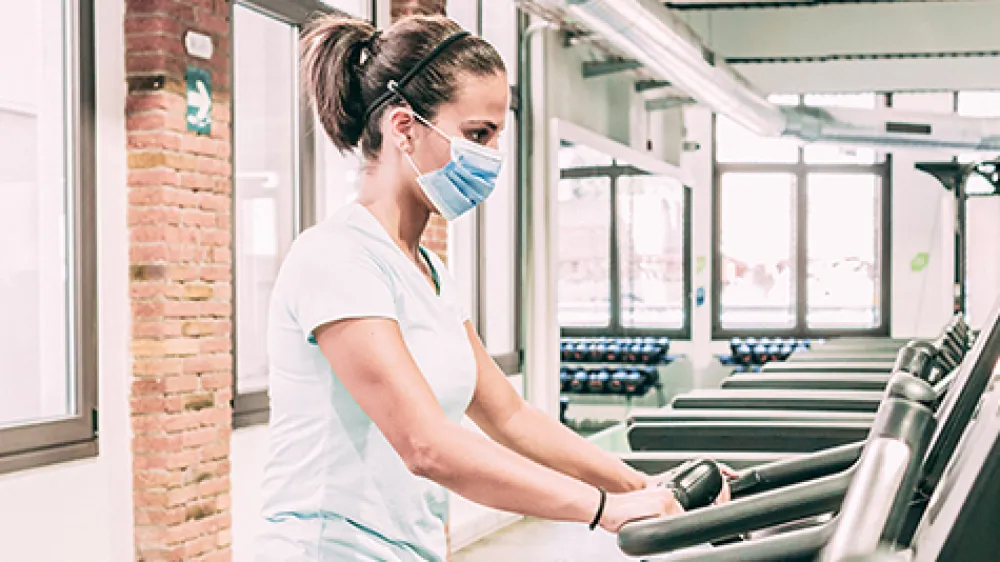Providing your location allows us to show you nearby locations and doctors.
The Do’s and Don’ts of Masks and Exercising

08/25/2020
Since the COVID-19 pandemic started, the COVID-15 has been a real problem for many of us. No, that isn’t a typo — the COVID-15 is the 15 pounds many of us have gained since gyms closed and we have been spending much more of our time at home.
With word from Governor Andrew Cuomo that gyms can start to reopen, the possibility of getting back to working out is starting to feel real.
A handful of natural questions quickly arise after hearing gyms can open. The first are related to safety: What are the risks of opening? Is it safe to do so?
Our public health officials are implementing a few restrictions to minimize risks as gyms open. State restrictions include limiting gym admittance to one-third of capacity, temperature checks and wearing masks at all times. Gyms must also maintain sign-in sheets to help contact tracers.
Wait, wearing a mask while exercising? The prospect of wearing a mask while running on the treadmill certainly raises a few more questions.
Do we have to wear masks? Should we wear masks? Is it safe to wear a mask while exercising? How do we wear one without dropping our oxygen levels dangerously low? Are people with heart or lung conditions at risk of a problem wearing a mask while exercising?
Let’s take a quick look at the do’s and don’ts of exercising and wearing masks.
DO talk to your doctor before beginning any exercise program, especially if you’ve been sedentary for a few months. The importance of a check-in with your doctor only increases if you have underlying medical conditions. The specific problems to be aware of are cardiovascular disease (prior heart attacks or stents, congestive heart failure, cardiac valve problems) and pulmonary disease (COPD, emphysema, chronic bronchitis, asthma). A quick visit with your doctor before beginning a new exercise program ensures you’re safe to start.
DON’T be concerned that a mask makes your oxygen levels drop. These masks are well-studied and don’t block the movement of air into your lungs. Even people admitted to the hospital don’t have a drop in their oxygen levels when wearing a mask. There is still air movement around the mask and the oxygen content of the air remains unchanged even with cloth on your face.
DO pay attention to how you feel. Wearing a mask can increase the amount of work it takes to get oxygen into your lungs because it increases the resistance with a physical barrier. Different types of masks will have different amounts of breathability. An N95 will make you feel shorter of breath than a cloth face mask.
DON’T take your mask off when you’re physically close to other people in the gym. This is both for your protection and for those around you. Just because someone doesn’t have symptoms of COVID-19 doesn’t mean that person doesn’t have the virus. That goes for both you and the people around you.
DO continue to keep physical distance from the people around you even when you’re wearing a mask. As research accumulates, the evidence for the effectiveness of masks in mitigating viral spread becomes stronger. But masks are imperfect and, even though they reduce risk of transmission, they don’t eliminate it.
DON’T give up on physical activity even if you can’t go to the gym. Go for a walk in your neighborhood, do a quick 15-minute home workout or just walk up the stairs every time there’s a TV commercial.
The pandemic has been hard for all of us. Opening gyms is an exciting opportunity for us to start getting back in shape and return to our regular lives. Here’s to the end of the COVID-15.
Dr. Gregory Katz is a cardiologist with The Heart Center, a division of Hudson Valley Cardiovascular Practice, P.C., now part of Nuvance Health. For more information on cardiovascular care and The Heart Center, visit www.nuvancehealth.org/heartcenter